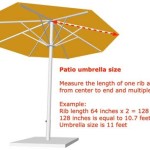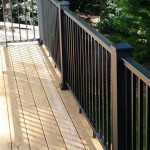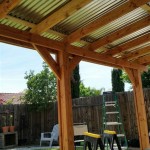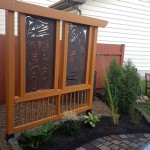Building A Small Patio With Pavers: Ideas & Implementation
Creating an outdoor living space, even a small one, can significantly enhance the enjoyment of a property. A paver patio offers a durable and aesthetically pleasing solution for transforming unused areas into functional and inviting spaces. Planning and execution are paramount to achieving a successful outcome. This article explores ideas and implementation strategies for building a small patio with pavers, focusing on key considerations for design, construction, and material selection.
Planning and Design Considerations
Before commencing any physical work, a thorough planning phase is essential. This stage defines the scope of the project, clarifies objectives, and establishes a firm foundation for the subsequent construction process. Accurate measurements of the intended patio area are the first step. This involves determining the length, width, and any irregularities in the space. These measurements directly influence the quantity of materials needed and the complexity of the design.
Consider the intended use of the patio. Will it primarily serve as a seating area, a dining space, or a combination of both? The answer to this question helps dictate the size and shape of the patio, as well as the type of furniture and accessories it will accommodate. A dining patio, for example, will need enough space to comfortably fit a table and chairs, with ample room for circulation around the perimeter.
The overall aesthetic of the patio should complement the existing landscape and architecture of the property. Consider the style of the house, the colors of the siding and trim, and the existing landscaping features. Choose pavers that harmonize with these elements to create a cohesive and visually appealing outdoor space. A modern home might benefit from sleek, rectangular pavers in neutral tones, while a more traditional home could be enhanced by textured pavers in earth tones.
Drainage is a critical factor in patio design. Proper drainage prevents water from pooling on the surface, which can lead to safety hazards and damage to the pavers over time. Ensure the patio has a slight slope away from the house to allow water to run off naturally. Consider installing a drainage system, such as a French drain, if the patio is located in an area with poor drainage.
Accessibility is another important aspect to consider. Ensure the patio is easily accessible from the house and other parts of the yard. Consider the path leading to the patio and make sure it is wide enough and stable enough for comfortable passage. For individuals with mobility issues, consider incorporating ramps or gentle slopes to make the patio more accessible.
Material Selection and Preparation
The selection of pavers is a crucial decision that impacts the appearance, durability, and cost of the patio. Pavers are available in a variety of materials, including concrete, brick, and natural stone. Concrete pavers are a popular choice due to their affordability, versatility, and wide range of colors and styles. Brick pavers offer a classic, timeless look but may be more expensive than concrete pavers. Natural stone pavers, such as flagstone or bluestone, provide a unique and natural aesthetic but are often the most expensive option.
The base material is equally important as the pavers themselves. A properly prepared base provides a stable and level surface for the pavers, preventing them from shifting or sinking over time. The base typically consists of two layers: a sub-base of compacted gravel and a bedding layer of sand. The sub-base provides a solid foundation, while the bedding layer provides a level surface for the pavers to sit on. The depth of the sub-base depends on the soil conditions and the expected load on the patio. In general, a sub-base of at least 4 inches is recommended.
Edge restraints are necessary to keep the pavers in place and prevent them from shifting outwards. Edge restraints can be made of various materials, including plastic, metal, or concrete. Plastic edge restraints are the most affordable option and are suitable for smaller patios. Metal edge restraints are more durable and provide a cleaner look. Concrete edge restraints are the most robust option and are suitable for larger patios or areas with heavy traffic.
Tools needed for the project include a shovel, a wheelbarrow, a compactor, a level, a measuring tape, a rubber mallet, a saw (for cutting pavers), and safety glasses. A plate compactor is essential for compacting the sub-base and ensuring a stable foundation. A level is crucial for creating a level surface for the pavers. A rubber mallet is used to gently tap the pavers into place without damaging them. A saw is necessary for cutting pavers to fit around edges and corners.
Construction Process and Techniques
The first step in the construction process is to excavate the area for the patio. Remove any existing vegetation, topsoil, and debris. Dig down to the required depth, taking into account the thickness of the pavers, the bedding layer, and the sub-base. Ensure the bottom of the excavation is level and compact it with a plate compactor.
Next, install the edge restraints around the perimeter of the patio. The edge restraints should be securely anchored to the ground to prevent them from shifting. Use stakes or other fasteners to hold the edge restraints in place while you backfill with gravel.
Spread a layer of compacted gravel over the excavated area to create the sub-base. Use a plate compactor to compact the gravel in layers, ensuring a solid and level foundation. The depth of the sub-base will depend on the soil conditions and the expected load on the patio, but a minimum of 4 inches is generally recommended.
Spread a layer of bedding sand over the compacted gravel. The bedding sand should be about 1 inch thick and should be evenly distributed. Use a screed board or a long, straight edge to level the sand and create a smooth, even surface for the pavers to sit on. Avoid walking on the leveled sand to prevent disturbing the surface.
Begin laying the pavers according to the chosen pattern. Start at one corner of the patio and work your way across, carefully placing each paver in the bedding sand. Use a rubber mallet to gently tap the pavers into place, ensuring they are level with each other. Maintain consistent spacing between the pavers.
After all the pavers have been laid, sweep sand into the joints between the pavers. Use a stiff brush to work the sand into the joints, filling them completely. Compact the sand with a plate compactor or by hand to ensure it is firmly packed. Add more sand as needed to fill any voids.
Finally, water the patio lightly to help settle the sand and compact the pavers. Allow the patio to dry completely before using it. Inspect the patio for any uneven pavers or gaps in the joints and make any necessary adjustments. Over time, the sand in the joints may settle, requiring additional sand to be added. Periodic maintenance, such as sweeping and cleaning, will help to keep the patio looking its best.
Paver Patio Design Ideas for Small Spaces
Small patios require careful consideration of space and design. Maximizing functionality and visual appeal is crucial when dealing with limited area. Here are some design ideas tailored for small paver patios:
Circular Patio with Fire Pit: A circular patio can create a cozy and intimate atmosphere. Integrate a fire pit in the center as a focal point and a source of warmth during cooler evenings. Surround the fire pit with comfortable seating, such as Adirondack chairs or a built-in bench.
Corner Patio with Vertical Garden: Utilize an unused corner of the yard to create a small patio. Incorporate a vertical garden along one or both walls to add greenery and visual interest. Choose plants that thrive in the specific climate and light conditions.
Patio Extension from Deck or Porch: Extend an existing deck or porch with a paver patio to create a seamless transition between indoor and outdoor spaces. Choose pavers that complement the materials and colors of the deck or porch.
Paver Pathway Leading to Patio: Create a paver pathway leading from the house to the patio to enhance accessibility and visual appeal. Use pavers that match or complement the patio pavers.
Multilevel Patio with Steps: If the yard has a slope, consider creating a multilevel patio with steps to add dimension and visual interest. Use retaining walls to create level areas for seating and entertaining.

Paver Patio Ideas Backyard Design Tips Unilock
10 Small Paver Patio Ideas Aspire

40 Paver Patio Ideas To Help You Design Your Outdoor Space

Paver Patio Ideas 5 Inspirational Designs For Comfortable Outdoor Living Leave Your Mark Llc

280 Sq Ft Small Paver Patio Design

Diy Paver Patio Backyard Project Old Salt Farm

Landscape Design 50 Beautiful Backyard Paver Patio Ideas

58 Beautiful Outdoor Patio Design Decor Ideas A Piece Of Rainbow

Paver Patio Ideas 5 Inspirational Designs For Comfortable Outdoor Living Leave Your Mark Llc

How To Build A Patio That Will Last Lifetime Easton Outdoors
Related Posts








